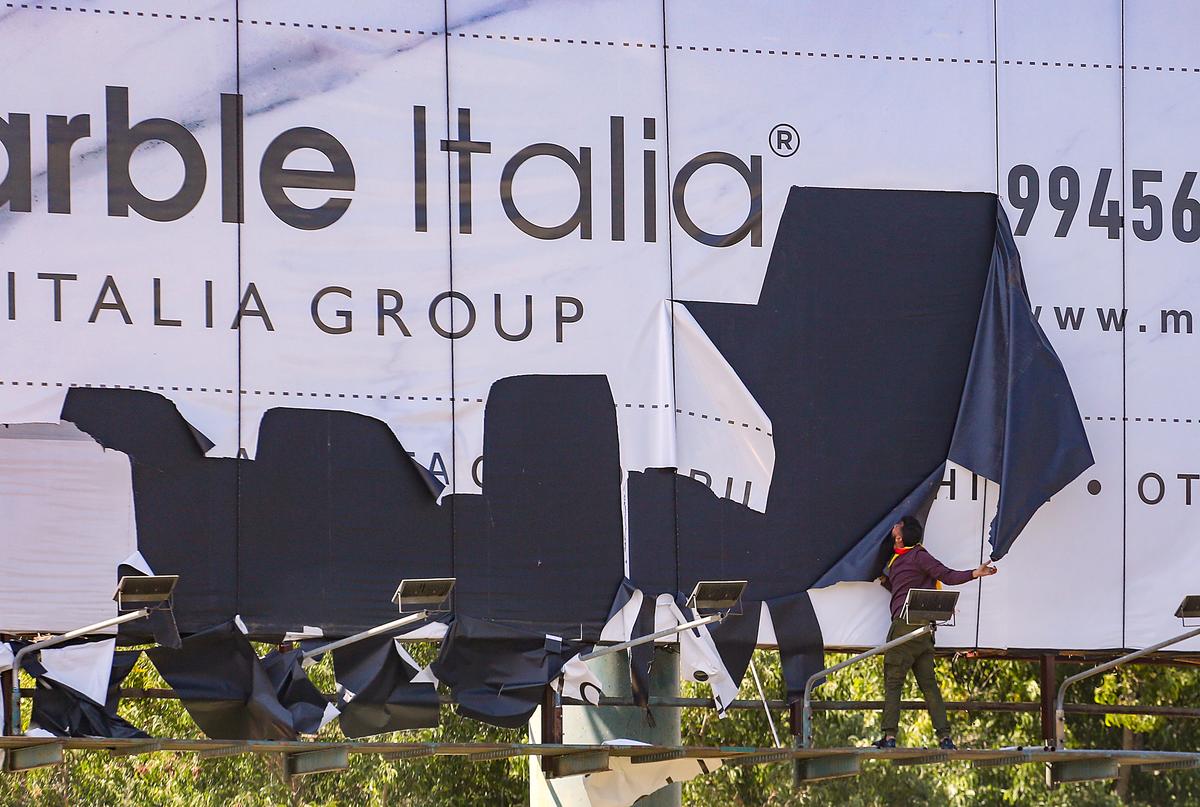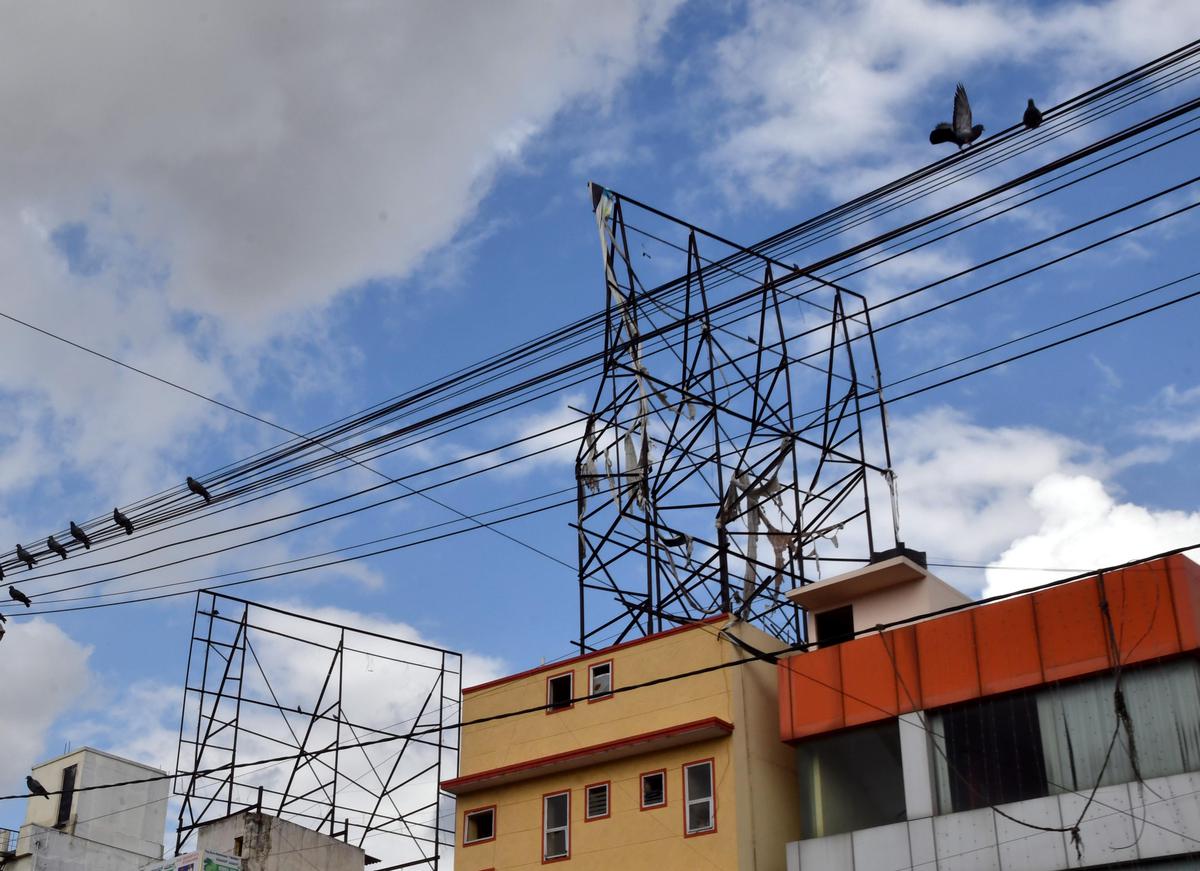Giant outdoor advertisement hoardings had once dominated Bengaluru’s skyline. But the exposê of a massive ₹2,000 crore scam linked to illegal hoardings eventually led to a ban. Blatant violations followed. Is the time ripe enough now to bring them back with a new advertisement byelaw drafted by the Bruhat Bengaluru Mahanagara Palike (BBMP) awaiting a final go-ahead from the State?
The Palike plan, as articulated in its BBMP Advertisement Bye Laws 2023, is this: Licences are to be auctioned to outdoor advertising firms to erect paid advertisement hoardings/billboards but only in private properties. The ban on commercial advertisements will continue on roads with width less than 60ft. But this regulation will not apply to roads in commercial and industrial zones.
In 2018, the BBMP Outdoor Advertisement and Public Message Byelaws prohibited all commercial ads except those under public-private partnerships. This followed an internal report by the then Palike Assistant Commissioner (advertisements) K. Mathai who pegged the revenue losses from illegal billboards at ₹2,000 crore.
The Outdoor Advertising Association, Bengaluru, approached the High Court challenging the byelaws and obtained a favourable order. The Court directed the BBMP to allow outdoor ads on private properties with restrictions.

A billboard is being vandalised by Karnataka Rakshana Vedike (Narayana Gowda faction) activists. The organisation on Wednesday targeted business establishments in Bengaluru and damaged their signboards and name plates which did not use Kannada. | Photo Credit: SHAILENDRA BHOJAK
Generous byelaws
What has raised eyebrows, however, is the generosity of the new byelaws. Depending on the road width, the area of the paid advertisement could vary from a minimum of 800 sqft to a maximum of 3,000 sqft with a height restriction of 75ft. Advertisers could display such billboards every 100m of the permitted road stretch. This is a far cry from 2018, when only 800 sqft hoardings were allowed within the city limits.
Urban planners and architects contend that this will aggravate the city’s visual pollution. Massive billboards at traffic intersections, for instance, are bound to hide several iconic buildings and other structures from public view.
“We have a precedent. Chennai and Delhi have banned them,” notes urban architect Naresh Narasimhan. “You can have them outside the city centre. In Bengaluru itself, outside the Outer Ring Road, immediately after the Hebbal flyover you have an overdose of hoardings. But within the city, it amounts to visual pollution, covering up all the greenery and signs of the city. It is an outdated concept, no western city allows it,” he points out.
A revenue generator
But the BBMP is unlikely to go by this argument. The BBMP budget has proposed to generate ₹500 crore annually from the hoardings that will come up once the new byelaws are green-signalled by the government. This is to be used for Brand Bengaluru works.
The budget statement talked about the new policy as a rational, transparent and regulated system of commercial and self-advertisements, drafted on the lines of the Supreme Court approved advertisement policy of the New Delhi Municipal Corporation. The Palike is convinced this will safeguard the city’s aesthetics and visual spaces.

Many dub these billboard skywalks as con-jobs and surrogate ads installed by a well-entrenched advertisement mafia. | Photo Credit: BHAGYA PRAKASH
Ad mafia
However, past experience shows the BBMP has a big problem with enforcement. As Chairman of BBMP Town Planning Committee, former Mayor and MLC, P.R. Ramesh recalls how he dealt with the menace in 2004: “There was a mafia behind poll ads. They would take permission for 100 ads, but install 300 to 400, even on footpaths obstructing pedestrians. There were many deaths too. We totally stopped the ads despite heavy pressure.”
Responding to a petition, the High Court had in January directed the State and BBMP to deposit ₹50 each for every illegal hoarding in the city. The Court sought an action taken report from the Palike on the illegal billboards.
Ramesh notes that even if BBMP promptly taxed the existing ones, that itself would yield a substantial revenue. “When I was Mayor, the agencies had not paid up. We started defacing the hoardings with spray paint. They voluntarily queued up, and paid about ₹30 crore. We need to take such measures. Byelaws are fine, but they have to implement it. It is very important to raise revenues,” he explains.
Tracking illegal ads with tech
Technology could be the answer to track the menace of illegal hoardings, suggests urbanist V Ravichander, who was a member of BBMP’s restructuring committee. “Today, technology allows the use of holograms, equivalent to a QR code that can be scanned from ground level to check if the hoarding is legitimate or not. Let the Palike generate a code each time a hoarding is permitted so that it is unique to that billboard. It carries the history of that hoarding, the start and end dates,” he explains.
Since a lot of hoardings spring up on private property, it makes sense for the BBMP to see the authorised ones as an incremental revenue source, says Ravichander. “A higher flat rate can be charged. The licence can be based on the location, density of traffic, low, medium or high. The flat rate could be higher if the traffic density is higher.”
Proxy skywalk ads
To work around the ban, advertisers in collusion with Palike insiders have been accused of erecting skywalks across the city. Massive billboards cover most of these structures, a clear sign that they were originally designed for advertisements and not pedestrians. Most skywalks are unused by walkers who prefer to cross roads at ground level.
Many dub these billboard skywalks as con-jobs and surrogate ads installed by a well-entrenched advertisement mafia. Ravichander agrees, and suggests a way to levy a hefty price: “Since these skywalks have come up for advertisements, they should be levied high traffic / high density rates by default. None of the skywalks should be in the low or medium category, but in the highest rate bracket,” he elaborates.
Metro pillar ads: Share revenue
The new byelaw permits paid ads on Metro pillars in a move aimed at helping the Bangalore Metro Rail Corporation (BMRCL) raise non-fare revenue. Ramesh insists that since the land belonged to the Palike, BBMP should get a share of the revenue or rent. “While tax revenue from advertisers is one source, this too is a mode of income for the Palike,” he explains.
The High Court has reiterated that it is not in favour of a complete ban on hoardings. Ramesh says the byelaws are fine, but should be implemented only after a broad discussion that deliberates on public safety and revenue share. What about urban aesthetics and visual pollution? Can a balance be struck?

